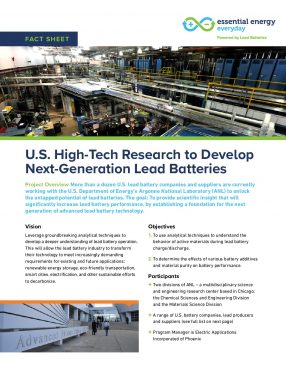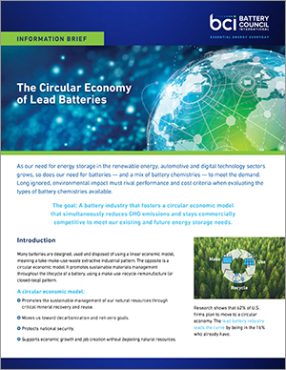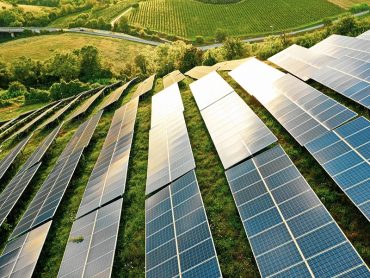
Guest blogger, John Howes, is the founder of Redland Energy Group where he has been a senior strategic advisor on energy policy and natural resources for nearly three decades. Below, he discusses how the election outcome will not likely deter the green agenda, which includes sustainable, domestically sourced lead batteries. The views expressed are those of the author.

Regardless of the November 3rd election outcome, the U.S. energy policy conversation around climate change and the strength of America’s domestic energy industry will continue.
One might think that Republican control of the White House and Senate for the past four years has stalled the green agenda. That’s not entirely true. Industry is incorporating green objectives to address supply chain shortages and sustainability, and individual states are taking bold steps. For example, California Governor Gavin Newsom recently signed an executive order that, by 2035, would ban the state’s sale of conventional vehicles powered by fossil fuels.
How Green Will Congress Go?
Given that United Nations climate researchers say that society has only 10 years to avert climate catastrophe, many environmentalists have been frustrated in their efforts to “decarbonize” the entire economy. They point to wildfires on the West Coast and hurricanes in the Southeast to justify the total elimination of fossil fuel extraction.
If Democrats win the White House, take control of the Senate, and maintain control of the House in November, the next Congress likely will spend more on energy research to pursue a green agenda. But would Congress go further and enact a nationwide program to phase out the use of fossil fuels? That would be highly controversial and depend on whether breakthroughs in green technologies can make them scalable and affordable.
Still, industry is embracing a green agenda in response to sentiment from investors and consumer groups, but not without significant challenges. Every automaker is adding electric vehicles (EVs) to its product line. However, because EVs remain more expensive than petroleum-fueled conventional vehicles, EV sales have yet to exceed 5% of total vehicle sales in the U.S.
Utility and Automotive Sectors Face Market and Supply Chain Challenges
In the case of electric power, many electric utilities are also responding to green-investor sentiment by adding more renewable energy to their grids. Yet, they say the complete elimination of fossil fuels by 2050 is impossible. Why? Because renewables cannot function as baseload power sources until the electric power industry is convinced the total lifecycle cost of energy storage – principally batteries – can decrease to the point where unsubsidized power from renewables can be economically competitive with natural gas to serve baseload requirements. .
The U.S. automotive and electric power industries have to confront another challenge: The reliance on imported materials and technologies to achieve green targets. This is particularly important in the case of batteries needed in EVs and for integrating power from wind and solar facilities to the grid. More than half the lithium-ion battery cells used in EVs and grid storage come from China.
Representatives Eric Swalwell (D-CA) and Guy Reschenthaler (R-PA) recently formed the bipartisan Critical Minerals Caucus to address this issue. In an October 1, 2020, webinar, Reschenthaler stated that the pandemic has dramatically affected the supply chain using rare earths and specialty metals such as lithium.
“We have 80% of those critical minerals coming from China. This should be alarming because we’ve seen China use their dominance of rare earth elements in other disputes … it didn’t go well,” he added.
The webinar’s moderator referenced a shocking World Bank study. It estimates that by 2050 the production need for minerals such as graphite, lithium and cobalt could increase by nearly 500% to meet the growing demand for clean energy technologies. In addition, more than 3 billion tons of minerals and metals will be needed to deploy wind, solar and geothermal power and energy storage. The majority of those resources will be sourced from outside the U.S.
Taking Action Now
Until we can resolve this reliance on imported technologies and materials, here’s what can be done:
- Greater Reliance on Natural Gas: For the electric power industry, the near-term answer is continued reliance on natural gas from domestic sources for generating electricity. Natural gas already has overtaken coal production and will provide more than half the required energy for the next 30–40 years. This has resulted in lower emissions of greenhouse gases. (Some environmentalists take a dim view of natural gas, which still emits greenhouse gases, albeit in amounts lower than coal.)
- Increased Use of Lead Batteries: For the auto industry, the near-term answer is continued improvement of the internal-combustion engine supported by more powerful lead batteries. They are more economical and sustainable than batteries made with imported lithium cells and drivetrains made with imported rare earth materials. This will help the industry stay profitable in the near term to invest in the long term.
- More Federal Research in Fundamental Science: For the federal government, the near-term answer is intensified research, particularly in fundamental science. The need for better air quality and climate change mitigation is certainly not ignored. However, merging those concerns with national security helps justify increased federal research funding.
What type of research? How to rearrange existing technologies into new products or services for applications like microgrids? That may be worthwhile in the near term, but the scientific community says that is insufficient.
What’s needed is a better understanding of how materials used in electronic devices (communications, medical, transportation, etc.) respond to external forces like extreme temperatures and natural degradation. That would enable materials to be used more efficiently and facilitate their recyclability. Lawmakers in the House and Senate appropriations committees are responding with significant increases in research funding.
Lead Batteries Attracting More Attention – and Research Funding
The Department of Energy (DOE) will continue its research into fostering a domestic lithium battery industry. But DOE also is expanding research into non-lithium technologies like lead batteries that are now part of a portfolio of technologies managed by the DOE Office of Electricity (OE), which is underwriting more research at the Argonne and Pacific Northwest National Laboratories. Why are lead batteries part of this DOE portfolio?
The North American lead battery industry is unique for its established domestic cradle-to-cradle infrastructure. No other battery chemistry comes close to the sustainability and low lifecycle cost profile of lead batteries with their 99% recycling rate.
The U.S scientific research community believes this continued research will help address national security concerns and benefit the environment. Strengthening a green-agenda, one that includes lead batteries, will remain an urgent national priority, beyond the election.








